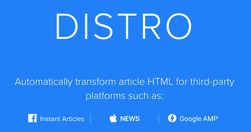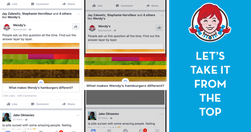
in some cases Facebook itself is earning revenue from their false stories... The design of Instant Articles ... obscuring information about a news source that could be used to help evaluate the content... additional false stories are promoted to a reader once they load a single Instant Article from a fake news site... company also specifically fo…

a way for publishers to combine multiple Instant Articles into one post.

Publishers are using Facebook’s latest Instant Articles update, which lets publishers post multiple articles within one post, to publish regular editions of must-read content straight to the platform.... akin to receiving a daily email with the day’s top stories, but readers won’t have to leave Facebook to get it... option to subscribe to get aler…

NBC News has found that people are willing to click through to its site when there’s breaking news, so it’s posting less of those articles on Instant Articles while posting more feature-type content... The New York Times ... tended to be long-form think pieces or analysis, not breaking news

all the pros and cons had to be considered. Here are some of the reasons and learnings behind this decision.

publishers are afraid that while the AMP project is nominally open-source, Google is using it to shape how the mobile web works, and in particular, to ensure a steady stream of advertising revenue

Gawker built a tool that pulls in the top 10 comment threads from its network of sites and displays them at the end of its Facebook Instant Articles... [and] Accelerated Mobile Pages... It’s not possible to comment straight on the Instant Article; people who want to add to the discussion have to log in on Gawker’s own sites. Disqus supports Googl…
Post’s website and mobile apps are a pleasure to use; the apps have been designed to serve different audiences depending on whether they are traditional Post readers or are instead interested in a more viral product offered at a lower price and that omits local news.... Bandito allows editors to publish articles with up to five different headlines…
The Atlantic expects native campaigns to drive 70 percent of its ad revenue this year, up from 60 percent in 2015... the NYTimes’ branded content division, T Brand Studio, now includes 70 staffers and will “deliver more than $50 million in revenue this year,” up from an estimated $35 million in 2014

Distro lets anyone transform an HTML article into the format mandated by one of the various platforms.

A year ago today, Facebook introduced Instant Articles... people are 20 percent more likely to read Instant Articles, which are accompanied by a lighting bolt icon in the feed, and 30 percent more likely to share them with friends...70 percent less likely to bounce... 30 percent more likely to share ...tests with some publishers where we help them…
Think about platforms as fishing places where you can find large, engaged audiences and build a relationship with them by providing content. Then offer these users some other services off-platform... Never outsource the future... a great primer for news organizations just starting to tackle the distributed world and a good checklist for those mor…

we’ll guide you through the ins and outs of Facebook’s publishing platform and how to get started.

I’m going through the motions of converting my old digital news startup, Muckgers, into a Facebook-first publication.. Theoretically, all you have to do is install a plugin, insert a few lines of code into the HTML of your website, connect your RSS feed to your publication’s Facebook page, submit 10 sample Instant Articles for review and, pending …
gadget “blog,” Circuit Breaker, that will live primarily as a Facebook page, with posts appearing in the Instant Articles format... the best of old-school blogging together with a sophisticated, aggressive modern platform distribution strategy... It’s not (yet) possible to be an Instant Articles publisher if you don’t have a web source from which…

Last spring, the Financial Times altered its former metered access model and introduced paid trials, letting users pay £1 ($1.42) for a month’s access to content. At the same time, the newspaper also changed its policies toward social platforms and began making more content free to people coming to its site from Google, Facebook and Twitter. It la…

At The Guardian’s Media Summit in London, those publishers and others discussed what’s working for them with their platform strategies, and how sustainable off-site publishing is likely to be for media companies in the long term... Cosmo’s Snapchat Discover editions get 76 percent completion rates... 56 percent ... coming back to us five days …

Email, for all the claims of it being dead, is critical for many publishers as a distribution (and marketing) channel they continue to control... Email newsletters have become an important part of publishers’ audience development strategies as a way to deepen their relationship with readers by providing an antidote to the endless stream of news in…
Enter the new editors of the Internet: giant, centralized tech companies that have created platforms... notably Facebook and Apple — want to be the newsstands of tomorrow: the place we go, inside their own ecosystems, to get our news and information... journalism organizations feel they have no alternative but to be part of those ecosystems. This …

Instant Articles, meet Instant Ads... an immersive way to reach people without making them leave the social network... when users click a Facebook News Feed ad connected to Canvas, it opens a full-screen, rich media page inside of Facebook rather than forcing users to wait for a mobile website to load... removes constraints that low-power mobile s…

Axel Springer, wary of being overly dependent on third-party platforms for traffic... fighting back by launching its own news aggregator platform... now has around 1,200 publishers on board ... Digiday spoke with Würtenberger, CEO of Upday, about using humans and algorithms for news sourcing, creating a platform for publishers and banning ad block…

Gawker Media CEO Nick Denton was an extreme skeptic of publishers relying too heavily on Facebook. Now he's ... “all in” on publishing directly to Facebook with its Instant Articles program, a backtracking on Denton’s well-publicized lament that publishers are too reliant on platforms...Facebook, with its deep pool of accurate user data, can help …

Another 13 U.K. publishers are signed up to start using Facebook’s Instant Articles, including The Daily Telegraph, The Mirror, The Daily Mail and The Economist, Sky News, sports site 90min.com and The Sun.The BBC and the Guardian were the first U.K. partners, and there are plenty more waiting in the wings.

Publishers like the New York Times should be having an existential crisis over Facebook’s instant articles. Instead they’re embracing them.. digital content is being divided between a lucrative high-end entertainment world,... and a low-end publishing world where content is expected to be “free,” ... a model that... might work to BuzzFeed’s adv…
By 2016, most content will be consumed ... on other people’s platforms... Snapchat Discover, Facebook Instant Articles, and Apple News... Google AMP is coming soon, and it will provide an Instant-like experience for not only Google users but also those using Twitter, Pinterest, and other platforms

for anyone outside Facebook’s Partner Publisher network, the new feature can be somewhat confusing.